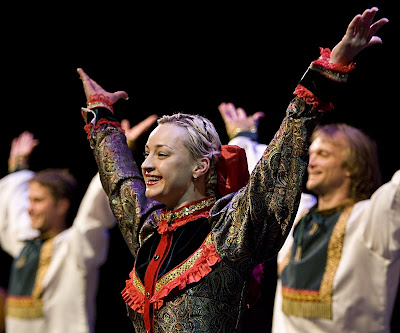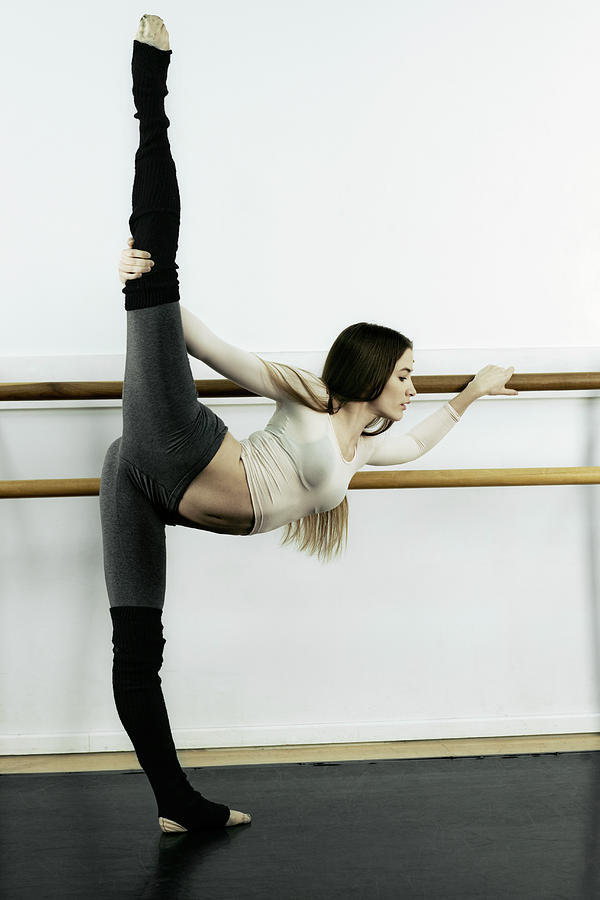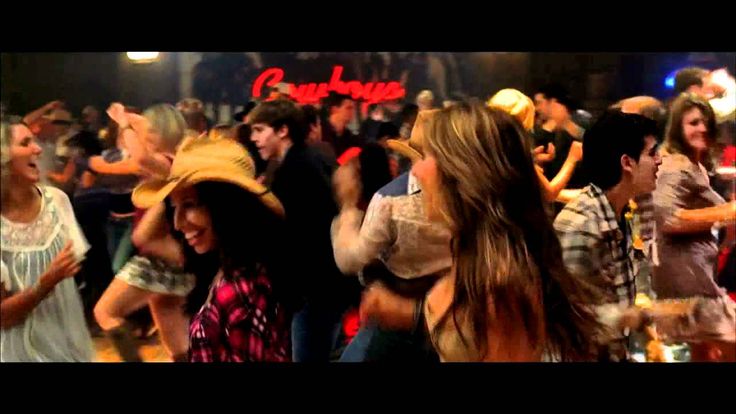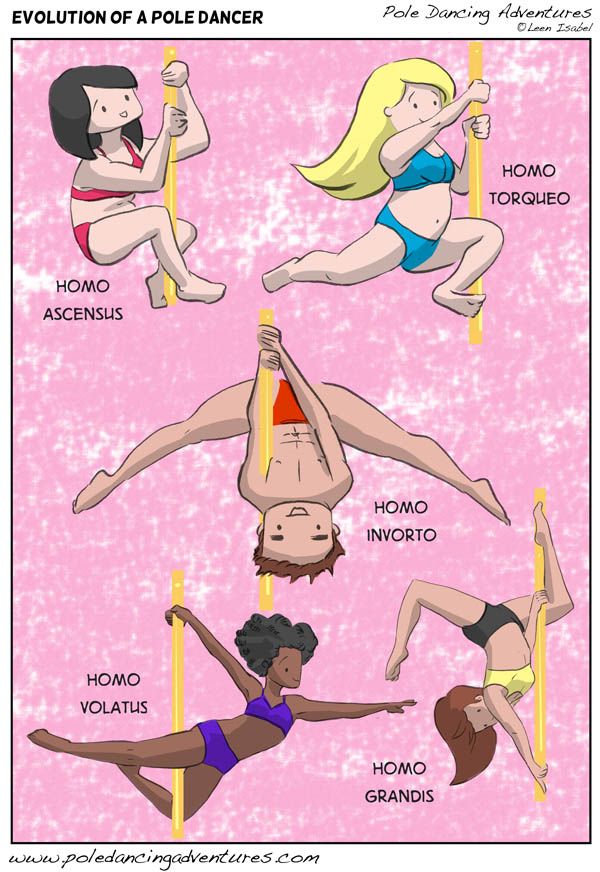How do russians dance
How to Dance like a Russian
From legendary folk dance to world-class ballet, Russia has a worldwide reputation for dance stretching back centuries. As any Russian would tell you, it is in their blood, and has become an intrinsic part of Russia’s national identity. As our way of paying homage to this much-loved art form, we will teach you about five Russian dances, from soaring leaps to high kicks and squats.
Prisyádka
When you think of ‘Russian dancing’ your mind probably conjures a man in a furry hat, doing a seemingly impossible, tip-toe squatted Can-can. The good news is that you’re right! This infamous dance isn’t simply a cartoon caricature of Russian culture, but the genuine thing; called, the prisyádka. The dance is an Eastern Slavic folk dance, not Cossack as many people assume. The moves originated centuries ago as a form of athletic competition, where excited onlookers would place bets as to which dancers would Kazotsky kick the most times, kick the highest or who might lose balance first. Reputation, masculinity and even fortunes have been won and lost for the sake of a Russian squat dance, and prisyádka is just the tip of the pointe shoe when it comes to the fascinating cultural history of Russian dance moves.
Russian Split
If you lack the balancing skills or leg muscles needed for successful squat dancing, you could attempt the gravity-defying ‘Russian Split’. This move, seen famously in figure skating routines performed by world-class skater Sasha Cohen, is a gazelle-like leap, achieving a straddle split five feet up in the air. Whilst these splits are considered ‘basic’ moves in the figure skating world, they are far from easy and when performed well and with height, they are breathtaking. In fact, a version of the Russian Split called the ‘Grande Jeté’ is one of the most exciting moves a ballerina can perform on stage. No wonder the best ballerinas in the world are Russian.
Khorovod
So perhaps not everyone can Kazotsky Kick or Russian Split, but there is good news for those of us who are less athletic. If you have little fingers, then this next dance could be perfect for you. The ancient Khorovod dance is documented for at least the last 1000 years in Russian and probably originates as far back as the dancing of Chorus groups in Ancient Greece. To get the moves right, you simply link pinkies with a fellow dancer and weave around the dance floor in a circular motion. In Belgorod, the locals achieved a world record of 2511 dancers in one Khorovod. But mind your geography, as in the Northern regions of Russia the dance is known to be gentle and restrained, but in the South, the dance has a more exciting reputation for hot-blooded frenetic movements and complex patterns.
If you have little fingers, then this next dance could be perfect for you. The ancient Khorovod dance is documented for at least the last 1000 years in Russian and probably originates as far back as the dancing of Chorus groups in Ancient Greece. To get the moves right, you simply link pinkies with a fellow dancer and weave around the dance floor in a circular motion. In Belgorod, the locals achieved a world record of 2511 dancers in one Khorovod. But mind your geography, as in the Northern regions of Russia the dance is known to be gentle and restrained, but in the South, the dance has a more exciting reputation for hot-blooded frenetic movements and complex patterns.
Troika (dance)
“But it is so hard to find a dance partner” I hear you cry. Well, should you find yourself in a dance hall where the number of women far outnumber the men then show no fear, simply request a ‘Troika’, a wholesome ménage a trois. Named after the traditional Russian ‘Troika’ chariots pulled by three horses, one man and two women imitate a prancing horse, much as you may have done as a child pretending to ride. With plenty of bouncing and elegant hoof work, you then duck under each other’s arms in a pleasing pattern. It’s a sociable and light-hearted folk dance that gives everyone a turn.
With plenty of bouncing and elegant hoof work, you then duck under each other’s arms in a pleasing pattern. It’s a sociable and light-hearted folk dance that gives everyone a turn.
Barynya
If you have no skill whatsoever, but possess determined enthusiasm for Russian cultural dances, then try the simple and passionate Barynya dance. Performed to lewd and humorous poem songs called ‘chastushkas’ in alternating tempos, this dance simply requires an un-choreographed, but heartfelt stomp around the dance floor. I think most of us can manage that at least.
So, there you are, five Russian dance moves for you to practice in your living room before you visit the real Russia and encounter these dances first-hand. But maybe wrap up the more valuable ornaments first!
- Comments
Rate this article:
Categories:
Number of views:
Tags:
Archive
-
2022, February 1
-
2022, January 3
-
2020, June 2
-
2020, May 4
-
2020, April 4
-
2020, March 4
-
2020, February 4
-
2020, January 5
-
2019, December 3
-
2019, November 5
-
2019, October 5
-
2019, September 4
-
2019, August 3
-
2019, July 1
-
2019, June 1
-
2019, April 2
-
2019, March 1
-
2019, February 5
-
2018, December 1
-
2018, October 3
-
2018, August 1
-
2018, July 3
-
2018, June 3
-
2018, May 8
-
2018, April 5
-
2018, March 2
-
2018, February 2
-
2018, January 4
-
2017, December 4
-
2017, November 3
-
2017, October 6
-
2017, September 2
-
2017, August 1
-
2017, July 3
-
2017, June 1
-
2017, May 3
-
2017, April 1
-
2017, March 1
-
2017, February 2
-
2016, August 2
-
2016, June 1
-
2016, January 2
-
2015, November 2
-
2015, October 4
-
2015, September 5
-
2015, August 4
-
2015, July 5
-
2015, June 6
-
2015, May 2
-
2015, April 2
-
2015, February 1
-
2015, January 3
-
2014, December 4
-
2014, November 1
-
2014, September 2
-
2014, August 2
-
2014, July 1
-
2014, June 2
-
2014, May 4
-
2014, April 2
-
2014, March 2
-
2014, February 2
-
2014, January 3
-
2013, November 1
-
2013, October 1
-
2013, September 5
-
2013, August 2
-
2013, July 4
-
2013, June 2
-
2013, May 4
-
2013, April 4
-
2013, March 3
-
2013, February 2
-
2013, January 4
-
2012, November 3
-
2012, October 8
-
2012, September 3
The Society of Folk Dance Historians (SFDH)
|
|
The Society of Folk Dance Historians (SFDH) Russian Dance and Music
[
Home |
About |
Encyclopedia | CLICK AN IMAGE TO ENLARGE |
EARLY DANCE HISTORY
The first Russian folk music and dance extends back into the 10th century, when Slavic tribes moved into Russia. The Slavs were known for their knowledge and mastery of instruments, songs, and dance. Because of the many invasions of the country and the resulting inter-cultural mix, many of the original dances have either been combined with each other into new forms or been lost over time.
The Slavs were known for their knowledge and mastery of instruments, songs, and dance. Because of the many invasions of the country and the resulting inter-cultural mix, many of the original dances have either been combined with each other into new forms or been lost over time.
The first dances were only known by the peasants and lowest classes. The upper classes and aristocracy did not dance themselves, but instead they enjoyed watching the performances of dance troupes and clowns. There also were "skomorkhi" (street entertainers) who sang and danced and performed tricks as they wandered from town to town.
FIRST BEAR DANCE
According to Russian dance director Mikhail Victorovich Smirnov, the first established record of Russian dance occurred in 907 CE when Vechishiy Oleg, first grand prince of Kiev, was celebrating his victory at Constantinople. Although his troops could not infiltrate the city walls, they did force the Greeks to enter into a treaty. At the celebration, male dancers dressed up like bears, and several dancing bears were clothed like Russians. At the end of the feast, Oleg demanded the bears be released back into the wild and the dancers be executed. Apparently, Oleg, who was partially blind, thought the dancers were from the northern tribes who owed him numerous tiger skins.
At the celebration, male dancers dressed up like bears, and several dancing bears were clothed like Russians. At the end of the feast, Oleg demanded the bears be released back into the wild and the dancers be executed. Apparently, Oleg, who was partially blind, thought the dancers were from the northern tribes who owed him numerous tiger skins.
HOLIDAY TRADITIONS
Some of the Russian folk songs and dances were associated with calendar events, such as planting and harvesting, and others with family rites, such as births, weddings, and funerals. Most Russian holidays have been celebrated in the fall and winter when the farming is over for the year. The entertainment begins with a prayer and is followed with an abundant feast, singing, dancing, and a series of entertaining fist fights or "stenka na stenku" (wall against wall).
FOLK DANCE CLOTHING
The clothing, that accompanied many of the dances, also was based on the event.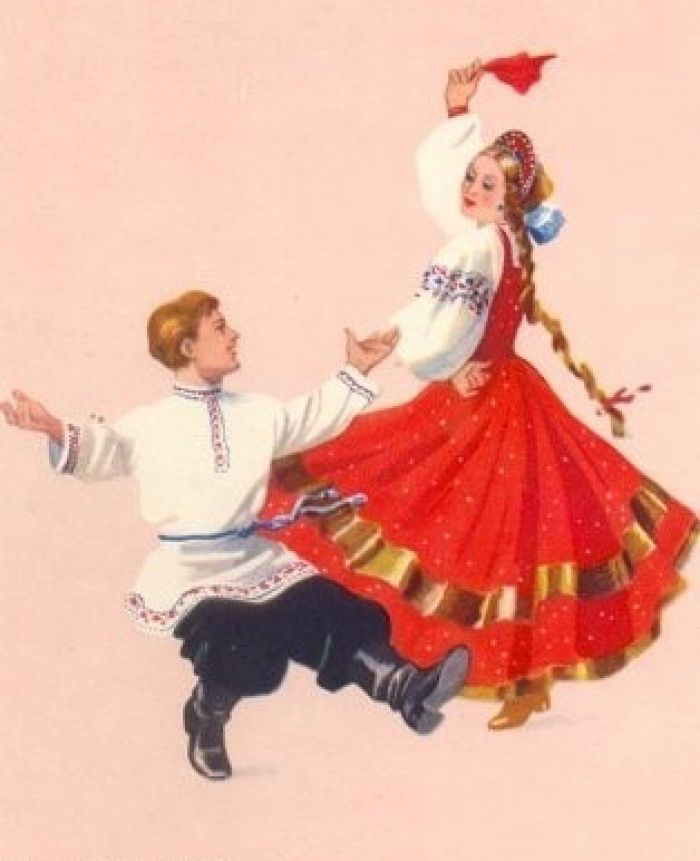 Holiday headwear included a "kokoshnik" (headdress) that was decorated with pearls and gold thread; embroidered and decorated blouse or shirt; "sarafan" (jumper), belt, and ornamented apron. The primary color was red, which meant "beautiful." The men wore "kosovortkas" (shirts) fastened on the side; belt; narrow trousers; semi-high or high boots.
Holiday headwear included a "kokoshnik" (headdress) that was decorated with pearls and gold thread; embroidered and decorated blouse or shirt; "sarafan" (jumper), belt, and ornamented apron. The primary color was red, which meant "beautiful." The men wore "kosovortkas" (shirts) fastened on the side; belt; narrow trousers; semi-high or high boots.
FIRST DANCE TROUPE
In 1937, the Soviets organized the first Russian folk dance troupe under the direction of Igor Moiseyev. The troupe continues to be one of the top performers of folk dance worldwide. The dancing ensemble with its traditional music, dance and song, that is popular in the West, keeps the audience clapping and shouting praise. Moiseyev died in 2008 at the age of 101.
The Moiseyev Company embodies all of the Russian traditional folk dance arts and preserves the folk culture. The classically trained are more than dancers. The men and women in their traditional belted tunics and bright red dresses are also acrobats, like today's break dancers, with bodies spinning and zig-zagging on the ground so fast they are almost impossible to see. The dancers fly into the air with their legs wide apart and their fingers touching their toes. While they are dancing, they are telling the story of the hundreds of years of Russian history and the many changes that occurred during the centuries.
The dancers fly into the air with their legs wide apart and their fingers touching their toes. While they are dancing, they are telling the story of the hundreds of years of Russian history and the many changes that occurred during the centuries.
EARLY MUSIC HISTORY
The roots of Russian folk music date as far back as to the middle of the first millenium, when Slavic tribes settled in the European part of the present territory of Russia. Those tribes were famous for their love and mastery of music, singing and dancing, according to Byzantium and German manuscripts. It is known that in 591 CE, Avars' khan sent Slavic singers and "gusli" (the oldest East Slavic multi-string plucked zither) players as ambassadors to the Byzantium Emperor. The music of Kievan Rus, the first Russian state formed in the 10th century, was not homogeneous, just like the tribes that made up this country. It included Finno-Ugric, Turkic, and other prototypes besides Slavic ones.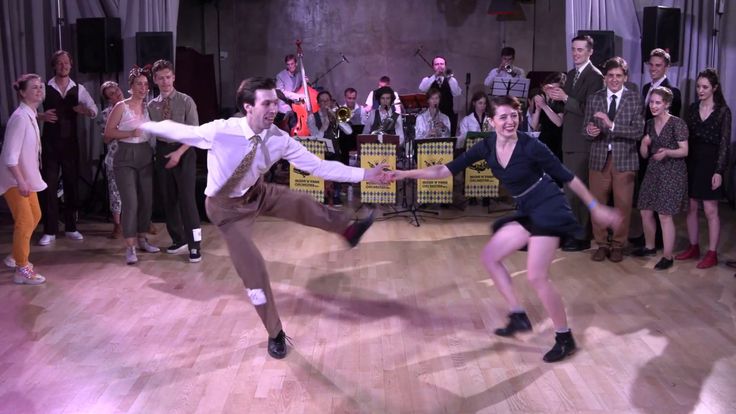
Guttural singing traditions of Siberia and the Far East are very old. Regional and ethnic (pre-national) traditions remain evident in Russian folklore. Thus, folk singing traditions of the northern, western, southern and central regions, as well as settlements in basins of big rivers of Oka, Volga and Don, have their own distinct features. The majority of still-alive folk songs have pagan roots bearing the impact of Christian rites.
Ethnic (folk) music in Russia can often be categorized according to the amount of authenticity in the performance: truly authentic folk music (reproductive performances of traditional music), folkloric, and fakeloric performance.
AUTHENTIC FOLK MUSIC
This music is closely tied in with the village life and traditions. It was usually not performed by music professionals. In recent years, there has been a marked decline in authentic folk performance practice. Festivals, competitions, and the work of ethnomusicologists have made attempts at preserving what has survived. In recent times, there has been a movement by musicologists to study and reproduce authentic folk music in an authentic performance style on the concert stage. This movement in Russia is spearheaded by members of the faculty of folk music at the Moscow Conservatory.
In recent times, there has been a movement by musicologists to study and reproduce authentic folk music in an authentic performance style on the concert stage. This movement in Russia is spearheaded by members of the faculty of folk music at the Moscow Conservatory.
FOLKLORIC MUSIC
This category includes music by groups led by music professionals, past and present, who have taken authentic musical material, and then arranged and performed it. It was widely accepted as 'authentically Russian' by Western audiences (conditioned, for instance, by performances of the Red Army Song and Dance Ensemble).
The category includes many of the regional folkloric ensembles and dance companies popular in the Russian Federation. Often, these folkloric ensembles specialize in collecting and maintaining the folk music traditions of the area of their origins which they service. They perform in stylized stage costumes based on the authentic costume designs used in the village, but modified for stage use.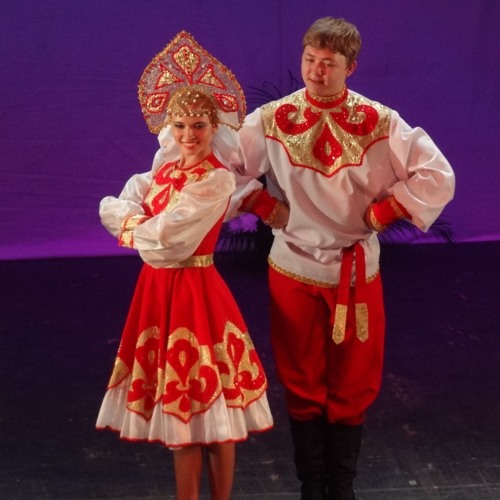 Most inauthentic, but widespread, was the practice of performing so-called Cossack "prysiadki" (low-squatting dances in perfect synchronization; as Professor Laura J. Olson observes, "this situation did not reflect actual Cossack traditions as much as it borrowed from the traditions of Russian ballet that dated to the late 19th century."
Most inauthentic, but widespread, was the practice of performing so-called Cossack "prysiadki" (low-squatting dances in perfect synchronization; as Professor Laura J. Olson observes, "this situation did not reflect actual Cossack traditions as much as it borrowed from the traditions of Russian ballet that dated to the late 19th century."
FAKELORIC MUSIC
Fakeloric music includes music composed by city intelligentsia and professional composers in a folkloric manner. Some sixty to eighty percent of contemporary Russian folk music marketed to the West is not "authentic" and can be loosely labeled as "fakeloric." Much of the music of the Russian folk instrument orchestras can also be categorized in this group as it is based on academic music traditions and playing techniques, only taking a folk element as its inspiration.
In recent times, music professionals who have completed diplomas in noted conservatories performing on Russian folk instruments are now questioning their "folkiness" when they perform, as none of their music was ever really performed originally by the (village) folk. Some now refer to their music as being academic folk music that to many academic musicians is an oxymoron.
Some now refer to their music as being academic folk music that to many academic musicians is an oxymoron.
VOCAL MUSIC
Authentic Russian folk music is primarily vocal. Russian folk song was an integral part of daily life in the village. It was sung from morning to night and reflected the four seasons and significant events in a villager's life. Its roots are in the orthodox church services where significant parts are sung. Most of the population also was illiterate and poverty stricken, meaning that resources for instruments could not be had and notation of any kind, which is more relevant for instrumentals than for vocals, could not be read.
Russian folk songs and dances were formed in two cycles: one of them is associated with calendar rites (sowing, harvest, etc.), while the other has to do with family rituals (wedding, birth, burial, etc.). The epoch of Old Rus is characteristic of heroic ballads singing the praises of noble princes and instrumental music (pipes, horns, tambourines, and kettle drums). Special place in song, folklore belongs to calendar song cycle; it consists of smaller cycles definitely timed to seasons and pagan festivals (often overlaid with Christian holidays).
Special place in song, folklore belongs to calendar song cycle; it consists of smaller cycles definitely timed to seasons and pagan festivals (often overlaid with Christian holidays).
Authentic village singing differs from academic singing styles. It is usually sung using just the chest register and is often called "white sound" or "white voice." It is often described as controlled screaming or shouting. Female chest register singers only have a low diapason (a grand swelling burst of harmony) of an octave to twelve notes.
INSTRUMENTAL MUSIC
Instrumental music for a long period was suppressed in Russia. In 1648, Tsar Alexis I of Russia, under the influence of then-prevalent views in the Russian Orthodox Church, banned the use of all musical instruments. At that time, it was stated that instruments were from the devil. Not easily verifiable today, but some historians also believe that traveling minstrels singing disrespectful songs about the Tsar to balalaika accompaniment, could have been the real reason. As a result of the ban, instrumental music traditions disappeared and did not have a fertile ground for development in Russia for many years. No musical instruments are used in Orthodox churches (in Russia).
As a result of the ban, instrumental music traditions disappeared and did not have a fertile ground for development in Russia for many years. No musical instruments are used in Orthodox churches (in Russia).
In the late 19th century, Vasily Andreyev, a salon violinist, took up the balalaika in his performances for French tourists to Petersburg. The music became popular and soon Andreyev had organized a club of balalaika players. This club grew into an orchestra, which in time grew into a movement.
From a simple unsophisticated three-stringed instrument, combined with an awakening "Russianness" in the last phases of the Tsarist Empire, the movement led to the development and implementation of many other Russian folk instruments.
The Russian folk instrument movement had its resonance in the cultures of other ethnic groups within Russia, the Soviet Union, and the Soviet Block countries. Folk instrument orchestras appeared in Belarus, Ukraine, Yugoslavia, Bulgaria, Moldavia, Romania, and Kyrgyzstan.
DOCUMENTS
- Igor Moiseyev, an article.
- Russia, a country.
- Russian Folk Dance, an article.
Taken from Internet sources.
Printed in Folk Dance Scene, August 2011.
This page © 2018 by Ron Houston.
Please do not copy any part of this page without including this copyright notice.
Please do not copy small portions out of context.
Please do not copy large portions without permission from Ron Houston.
round dance, quadrille, tank, Kalinka, lady, Cossack, squatting.
Publications of the Traditions section
Let's remember how they danced in Rus'. Kamarinskaya and the mistress, a Cossack and a quadrille, a round dance and a fair dance with a bear. Not a single holiday in Rus' was complete without dance. The dances were named after the melody, the number of dancers or the pattern of movements. The dances were lyrical or martial. One for each case. The soul sings - the legs start dancing .
One for each case. The soul sings - the legs start dancing .
Khorovod . Dance with pagan roots. Circle in honor of Yarila, the ancient god of the sun. "Walking after the sun" is part of the Slavic rites. Over the centuries, the ritual character has faded into the background. The round dance has become the main decoration of Russian folk holidays. The nature of the dance changes from occasion to occasion. Either they start a round dance in honor of the arrival of spring, then they meet Ivan Kupala, holding hands, scarves or girlish wreaths.
Trinity . A folk dance that can be unmistakably recognized by counting the dancers. Initially, it was a man and two women. Rhythm and steps are like in a Russian trio of galloping horses. The troika is danced not only by folk dance groups, but also on the classical stage. As, for example, in the ballet The Nutcracker to the music of Pyotr Ilyich Tchaikovsky.
Kalinka .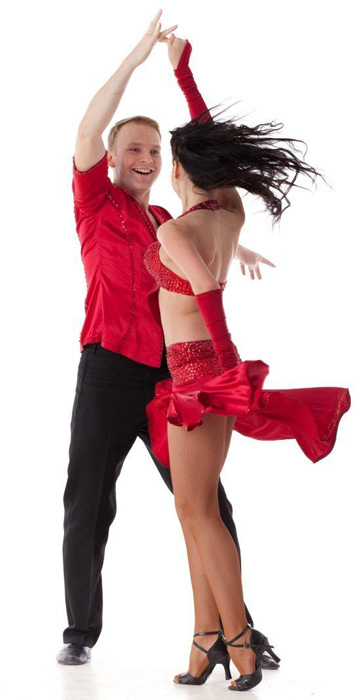 A dance performed to a song that is only reputed to be folk. Authorship belongs to Ivan Larionov. The Russian composer and folklorist wrote Kalinka in 1860. The melody went straight to the people from the stage of the Saratov amateur theater. There are no special choreographic figures in Kalinka: it is an improvisation dance. Including on ice, as in the case of figure skaters Irina Rodnina and Alexander Zaitsev.
A dance performed to a song that is only reputed to be folk. Authorship belongs to Ivan Larionov. The Russian composer and folklorist wrote Kalinka in 1860. The melody went straight to the people from the stage of the Saratov amateur theater. There are no special choreographic figures in Kalinka: it is an improvisation dance. Including on ice, as in the case of figure skaters Irina Rodnina and Alexander Zaitsev.
Khorovod
Kalinka
Lady . A daring dance like a "social conflict" in the spirit of who will dance whom. The main characters are the "Madame-Lady" and the "Peasant Muzhik". To the accompaniment of an accordion or balalaika, majesty opposes prowess, smoothness of movement versus dexterity. According to one of the versions, the Oryol province became the birthplace of the dance.
Kamarinskaya . The dance "hands on hips, from heel to toe" became a fantasy for the orchestra. Mikhail Glinka in his overture used the melody itself and the overtones characteristic of folk singing, and Pyotr Tchaikovsky included the theme in the "Children's Album".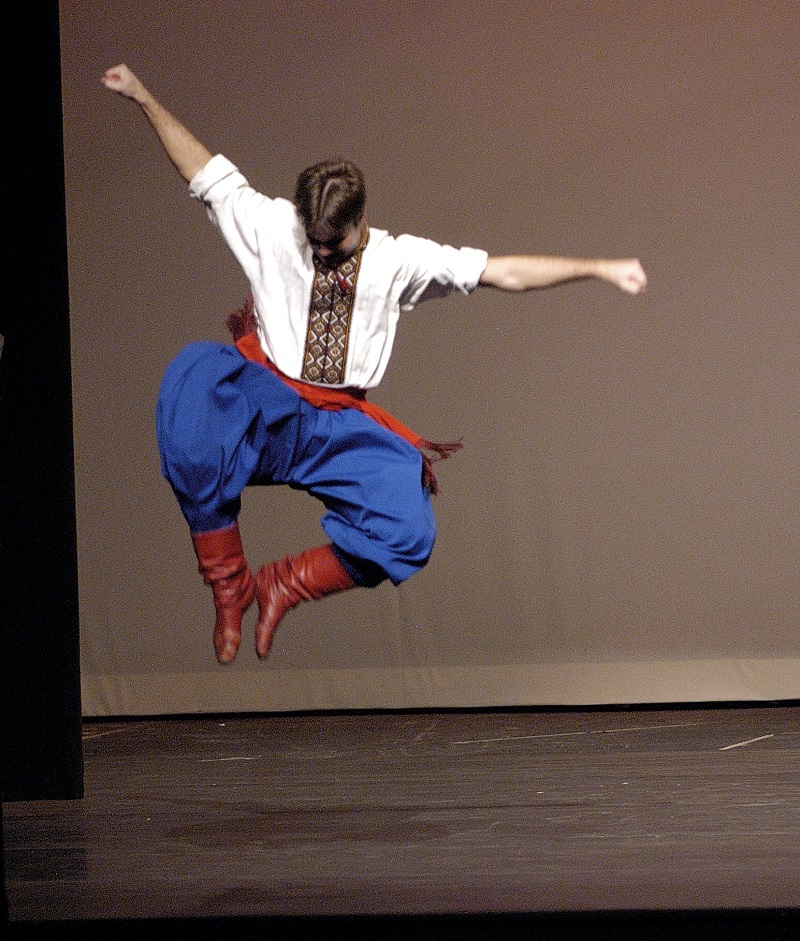 The main role of the dance version is played by the “Kamarin peasant”, a cheerful and provocative resident of Kamarichi, the volost of the Oryol province.
The main role of the dance version is played by the “Kamarin peasant”, a cheerful and provocative resident of Kamarichi, the volost of the Oryol province.
Cossack . Russian, Terek, Kuban. The dance is international with squats, pair dances and jumps. The peppy and fervent melody of a Cossack girl has been known since the 18th century. The glory of folk dance reached the Parisian salons along with the Russian troops. Alexander Dargomyzhsky wrote "Little Russian Cossack" for the symphony orchestra, and since the 19th century, the Cossack in Russia was "promoted" to a ballroom dance.
Kazachok
Russian folk dance
Russian folk dance
See also:
- Vesnyanka and round dances. Rites and traditions: from Easter to Krasnaya Gorka
- Test for knowledge of Slavic traditions
- "Birch". The secret of the floating step
Squatting . Dance as an element of combat. Initially, Slavic warriors squatted on the attack, and in the time of Suvorov they competed in the "combat squat" along with drill and shooting. Either an acrobatics exercise, or a dance that raises morale. In the Vologda Oblast, a century ago, they competed in dances, throwing knees, and the naval squatting dance was called "Apple" - after the name of the tune.
Initially, Slavic warriors squatted on the attack, and in the time of Suvorov they competed in the "combat squat" along with drill and shooting. Either an acrobatics exercise, or a dance that raises morale. In the Vologda Oblast, a century ago, they competed in dances, throwing knees, and the naval squatting dance was called "Apple" - after the name of the tune.
Quadrille . From a French village to a Russian one through noble assemblies. Russified French dance in Russia has acquired its own traditions. The dance meeting of several couples has grown into a real romance in a dance with many chapters: "acquaintance", "walk", "separation", "farewell". Supplemented with a ditty, the quadrille became the first dance in the village.
Tank . More than a dance - a rite in which the song, movements, games came together. The tradition originated in the Kursk and Belgorod lands. The locals diversified the usual round dances and endowed them with a special meaning. In each village in its own way: in one line, with belts, in four rows, with towels, a tank of young girls moves to the place of the festivities. To start dancing in all sorts of ways, following traditions and one's own imagination.
In each village in its own way: in one line, with belts, in four rows, with towels, a tank of young girls moves to the place of the festivities. To start dancing in all sorts of ways, following traditions and one's own imagination.
Tank
Russian folk dance
Russian folk dance
Tags:
Slavic cultureTraditionsFolklorePublications of the Traditions section National Unity Day occupies a special place among the public holidays of modern Russia. The term "unity" itself means the interconnection of processes, which forms an integral system of interaction. Of course, friendship between the peoples living in Russia has been and remains such a system for many centuries.
All peoples are our pride,
There are many of them, and this is a plus.
After all, without us there would be no Russia,
The one I'm proud of.
Russia is famous as a multinational state, more than 190 peoples live on the territory of the country. Each nation is distinguished by its history, culture and heritage, strives to preserve the language, customs and traditional occupations and crafts. The wealth of national cultures is the property of the whole country.
The wealth of national cultures is the property of the whole country.
The most important thing in living together is to learn to respect the traditions of each nation. We will try to introduce you to the cultural traditions of different nations, in particular those related to music and dance. Today we will pay attention to Russian dances.
Russians are the largest indigenous ethnic group living in Russia. More than 110 (almost 79% of the total population of the country) millions of Russians live in the Russian Federation, most of the Russians also live in Ukraine, Kazakhstan and Belarus. If we look at the map of Russia, then the Russian people are distributed in large numbers throughout the entire territory of the state, living in each region of the country ...
Their choreographic structure is taken as the basis for the classification of Russian folk dances. Russian folk dance is divided into two main genres - round dance and dance, which in turn consist of various types. A round dance is a so-called dance, song, game; synchronous movement and performance of a round dance song. The dancers hold hands. In Russia, there are local features of the performance of round dances. Variety in costumes, movements, transitions - this is what distinguishes the round dance from other dances. Dance drawings, figures can be both female and male, and joint. Round dances are often danced to vocal accompaniment, a song that has action. The participants of the round dance try to stage the content of the song. Round dances are ornamental and playful.
A round dance is a so-called dance, song, game; synchronous movement and performance of a round dance song. The dancers hold hands. In Russia, there are local features of the performance of round dances. Variety in costumes, movements, transitions - this is what distinguishes the round dance from other dances. Dance drawings, figures can be both female and male, and joint. Round dances are often danced to vocal accompaniment, a song that has action. The participants of the round dance try to stage the content of the song. Round dances are ornamental and playful.
Dances or dances are early ritual, and now they are everyday dances. This dance was formed from a round dance, increasing the pace of performance and diversifying the patterns of transitions and constructions. The dance is a movement that becomes more and more diverse with each measure, which is a characteristic feature of the dance. Boys and girls take part in this dance. The dance is a competition. Guys compete in dexterity, strength, prowess, individuality. This is an exclusively male dance. The dance is performed to standard folk melodies or ditties. At present, the dance is performed as follows: several dancers from two sides stand opposite each other and begin to dance in vying. A mass dance is a paired, non-stage dance without age and gender, it is permissible to dance it for everyone indiscriminately. In this dance there is no age limit or number of participants. Group dance is a mass dance without specific complex patterns and constructions, mainly round dance transitions, improvisations.
This is an exclusively male dance. The dance is performed to standard folk melodies or ditties. At present, the dance is performed as follows: several dancers from two sides stand opposite each other and begin to dance in vying. A mass dance is a paired, non-stage dance without age and gender, it is permissible to dance it for everyone indiscriminately. In this dance there is no age limit or number of participants. Group dance is a mass dance without specific complex patterns and constructions, mainly round dance transitions, improvisations.
Barynya is a Russian folk dance, as well as the music to which this dance is performed. The general mood of the dance is fervently ironic (joking). When performed in pairs, the dancer and the dancer dance alternately (dance), as if competing with each other. The dance was based on the conflict between the “lady” (landowner) and the “muzhik” (peasant). The dancer expressed majesty, and the dancer - dexterity and prowess. During the dance, the phrase sounds like a refrain: “Mistress-lady, lady madam! »
Birch is a round dance typical of central Russia and Belarus. The pace is slow to moderately fast. In some areas, it was performed by girls during spring calls, a mandatory attribute is birch branches, which the performers hold in their hands. Also known as a couple village dance, not associated with ritual action. The characteristic elements of the dance are simple steps in a circle and the simultaneous squatting of all performers to a certain beat of the music. The dance is accompanied by numerous and varied choruses. In the Minsk region, the dance accompanied the game "Tereshka's Marriage"
The pace is slow to moderately fast. In some areas, it was performed by girls during spring calls, a mandatory attribute is birch branches, which the performers hold in their hands. Also known as a couple village dance, not associated with ritual action. The characteristic elements of the dance are simple steps in a circle and the simultaneous squatting of all performers to a certain beat of the music. The dance is accompanied by numerous and varied choruses. In the Minsk region, the dance accompanied the game "Tereshka's Marriage"
Bychok is a traditional Belarusian and Russian dance. The pace is moderate or fast. Known in several choreographic versions: the most ancient one is close to round dances, in which the dancers imitated butting gobies; the later ones approach the quadrille; there are solo improvised versions. The bull-calf could be an integral part of the Belarusian rite "Tereshka's Marriage", where it was performed under ditties; for example, in the Vitebsk region they sang: Oh, matulechka, bullock, bullock, bullock, The dacha was walking, dacha, dacha, Ah, matulechka, tsyalushachka, The dacha was walking.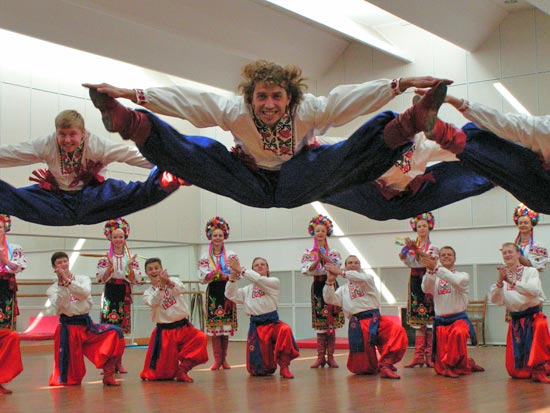 Russian "Bychok" dance to the sounds of the balalaika and the song of the same name
Russian "Bychok" dance to the sounds of the balalaika and the song of the same name
Golubets (pigeon dance) is an old Russian folk dance, which depicts a quarrel and reconciliation of two lovers. It started at a very slow pace. Each danced in his own character and kicked in his own way. The girl stood in one place, trying to turn her face away from the guy who walked around her, imitating a dove caring for a dove in the spring. Then the tempo of the music accelerated, the guy began to step on the girl more energetically, making various bends, trying to show his prowess. The girl was more and more friendly to her partner and no longer tried to leave him, and then she walked towards him, shaking her hips, shoulders, smoothly waving her arms. Only sometimes in the finale, the guy and the girl, holding hands, make several turns in a circle, it happens even less often that the guy, embracing the girl, circles with her. The dance ended with an imitation of intercourse. The dance, as a rule, ended in the middle of the circle with a mutual bow
Zhuravl (Belarusian Zhuravel) is a Belarusian, Cossack, Russian, Ukrainian dance game, where the main character was the “crane”. It comes from a round dance and is one of the oldest Slavic dances [2]. Until the 19th century, it was part of a magical ceremony at weddings, and is also associated with caroling. Several girls dance, others protect them from the "cranes" (guys), sing, for example:0003
It comes from a round dance and is one of the oldest Slavic dances [2]. Until the 19th century, it was part of a magical ceremony at weddings, and is also associated with caroling. Several girls dance, others protect them from the "cranes" (guys), sing, for example:0003
The lads went softly, Drank boldly…
In another version, the performers slowly raise either the right or the left leg, imitating the steps of a crane. In the center of the circle, a guy walks - "crane". If the couples are spinning, the "crane" seeks to snatch some girl from the hands of the gentleman. The girls sing:
Yes, the crane Yes, yes, our canapels ...
When the girls shout: “Grab, the crane!” - he should grab the girl by the hand and dance one circle with her. The “crane” in the circle is the guy without a pair. The game "At the Crane" is also known, in which the characters were "mother", "crane" and "children". The "mother" is talking to the "crane" who wants to catch and eat the "children".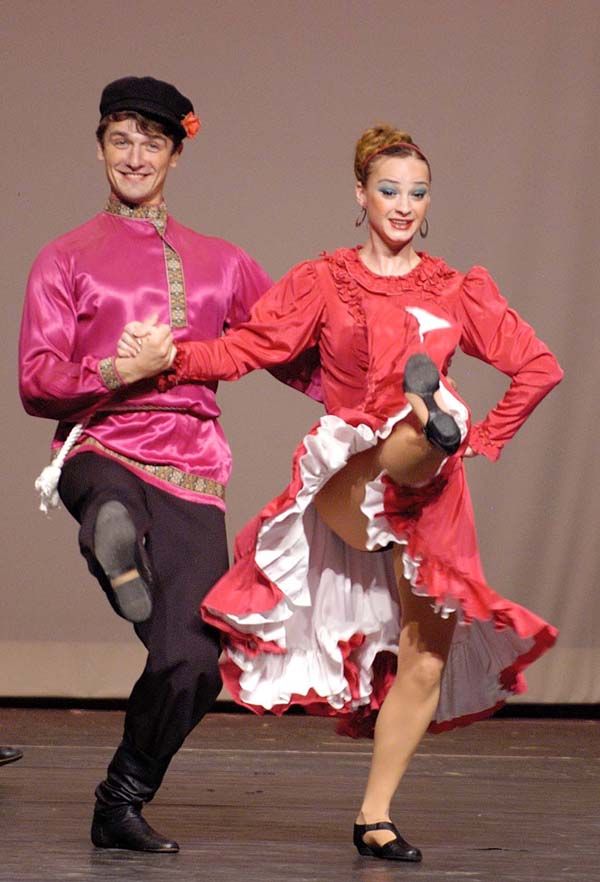 The "crane" grabs the "children", they catch the thief and peck him on the top of his head with their fingers. The same is done with the “mother”, if she did not save the “children”. In dances and games about the crane, ancient beliefs in the cult of birds (animal totemism) are manifested. According to the observations of N. N. Nikolsky, in Polissya the crane was considered “the giver of all kindness”
The "crane" grabs the "children", they catch the thief and peck him on the top of his head with their fingers. The same is done with the “mother”, if she did not save the “children”. In dances and games about the crane, ancient beliefs in the cult of birds (animal totemism) are manifested. According to the observations of N. N. Nikolsky, in Polissya the crane was considered “the giver of all kindness”
Cossack - Russian and Ukrainian folk dance. Among the varieties of the Cossack, Ukrainian, Russian, Kuban and Terek are distinguished. The general mood of the dance is lively, cheerful, cheerful and provocative. The dance is similar to hopak, but contains less acrobatic moments and is more lyrical (rather than combative) in nature.
Kalinka dance based on folk movements. Sometimes "Kalinka" becomes synonymous with improvisational Russian dance in general, where traditional squatting dance techniques, round dance and other elements are used. The movements consist of stately movements in a circle with a spread of arms in different directions.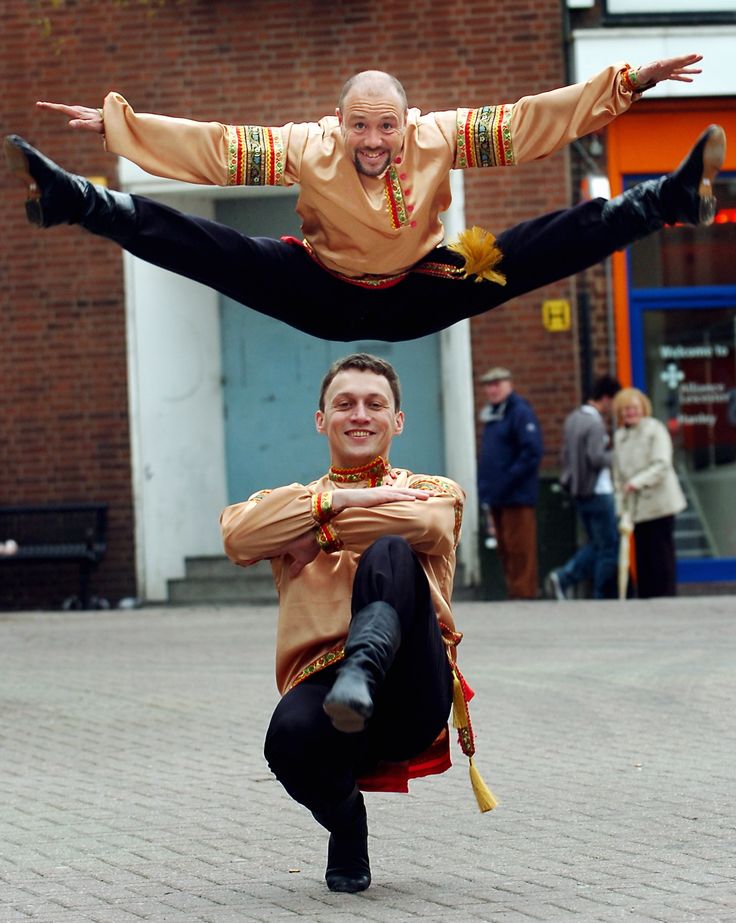
Kamarinskaya dance. The dance is based on step movements. The foot is placed on the heel, then on the toe. This element has received various designations of heeling, trampling (knocking mud off the boot). Hands "to the sides", then open in different directions. There is also an element of crouching, jumping, spinning and walking in a circle. During the dance, the dancer claps his hands, on his stomach and on his heels.
Matanya (dance) - Russian dance with the performance of ditty verses to a special tune The dance "Matanya" goes in a circle or in a circle, where the accompanying instrument (or instrumental group) can be in the center of the circle, or outside the circle or in a circle along with the singing . At the time of the performance of the verse, the singer does not dance, accompanying the performance with artistic gestures. The rest of the participants of the action, as it were, “save” their movements, saving energy for a loss, where the dance unfolds “from the heart”
Metelitsa is a Russian, Ukrainian and Belarusian folk game dance with a quick change of figures and various whirling, reminiscent of a blizzard. The dancers are spinning in a swift round dance, depicting a blizzard. The blizzard is performed along with singing or only to music. The round dance of the "blizzard" is built on one or two simple movements. The leading couple carries along the whole string of dancers, either in a circle, or in a figure of eight, or in a “snail”, and sometimes twists everyone into a “snowdrift”, crowded in the center.
The dancers are spinning in a swift round dance, depicting a blizzard. The blizzard is performed along with singing or only to music. The round dance of the "blizzard" is built on one or two simple movements. The leading couple carries along the whole string of dancers, either in a circle, or in a figure of eight, or in a “snail”, and sometimes twists everyone into a “snowdrift”, crowded in the center.
Russian dance is a kind of Russian folk dance. The dance is a movement that becomes more and more diverse with each measure, which is a characteristic feature of the dance. Russian dance is improvisational in nature. Each region of Russia has its own local type of dance. Previously, it was a ritual, but now it is an everyday dance.
Tanki is an ancient South Russian and Ukrainian folk mass ritual dance, with song and game elements. Tanki are close to round dances. The concept of “driving tanks” corresponds to the all-Russian concept of “driving round dances”. Among the Kuryans, "to drive tanks" corresponds to the all-Russian "to drive round dances. " However, the definitions of "tank" are different. In one case, tanks coincide with round dances: “round dances are conducted with the singing of old songs. These round dances are called tanks”; in another, they are independent: "they led tanks and a round dance"; and in the third they are part of a round dance: “they drive tanks, forming a round dance,” and “a crooked tank is no longer just a round dance, but the highest development of a round dance.” Sometimes tanks mean the same thing as round dances-games: "they drive tanks, that is, round dances connected with certain movements called games."
" However, the definitions of "tank" are different. In one case, tanks coincide with round dances: “round dances are conducted with the singing of old songs. These round dances are called tanks”; in another, they are independent: "they led tanks and a round dance"; and in the third they are part of a round dance: “they drive tanks, forming a round dance,” and “a crooked tank is no longer just a round dance, but the highest development of a round dance.” Sometimes tanks mean the same thing as round dances-games: "they drive tanks, that is, round dances connected with certain movements called games."
Trepak (from “to wag”) is an old Russian dance, also common in Ukraine. It is performed at a fast tempo, in two beats. The main movements are fractional steps, trampling and squatting with throwing out legs. The main position of the hands on the belt. The movements were composed by the performer on the go. In terms of properties, it has much in common with "Kamarinskaya" and "Lady": either a single male dance, or a dance.